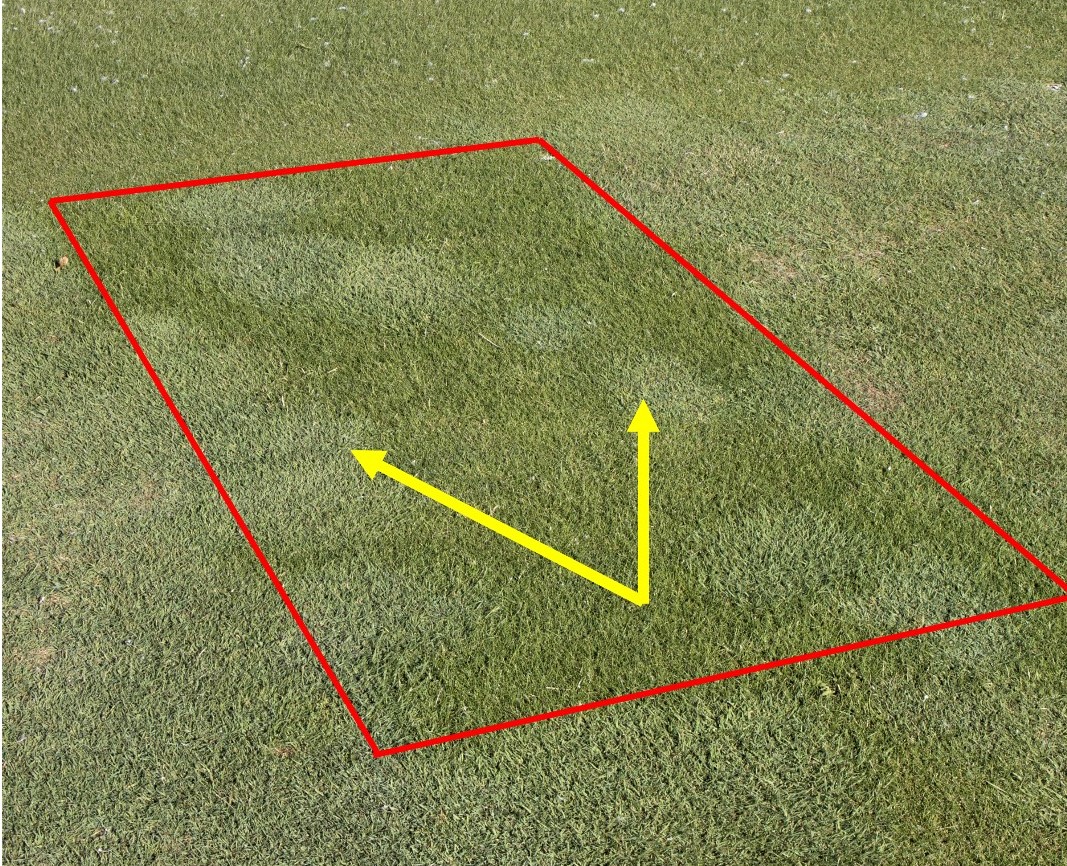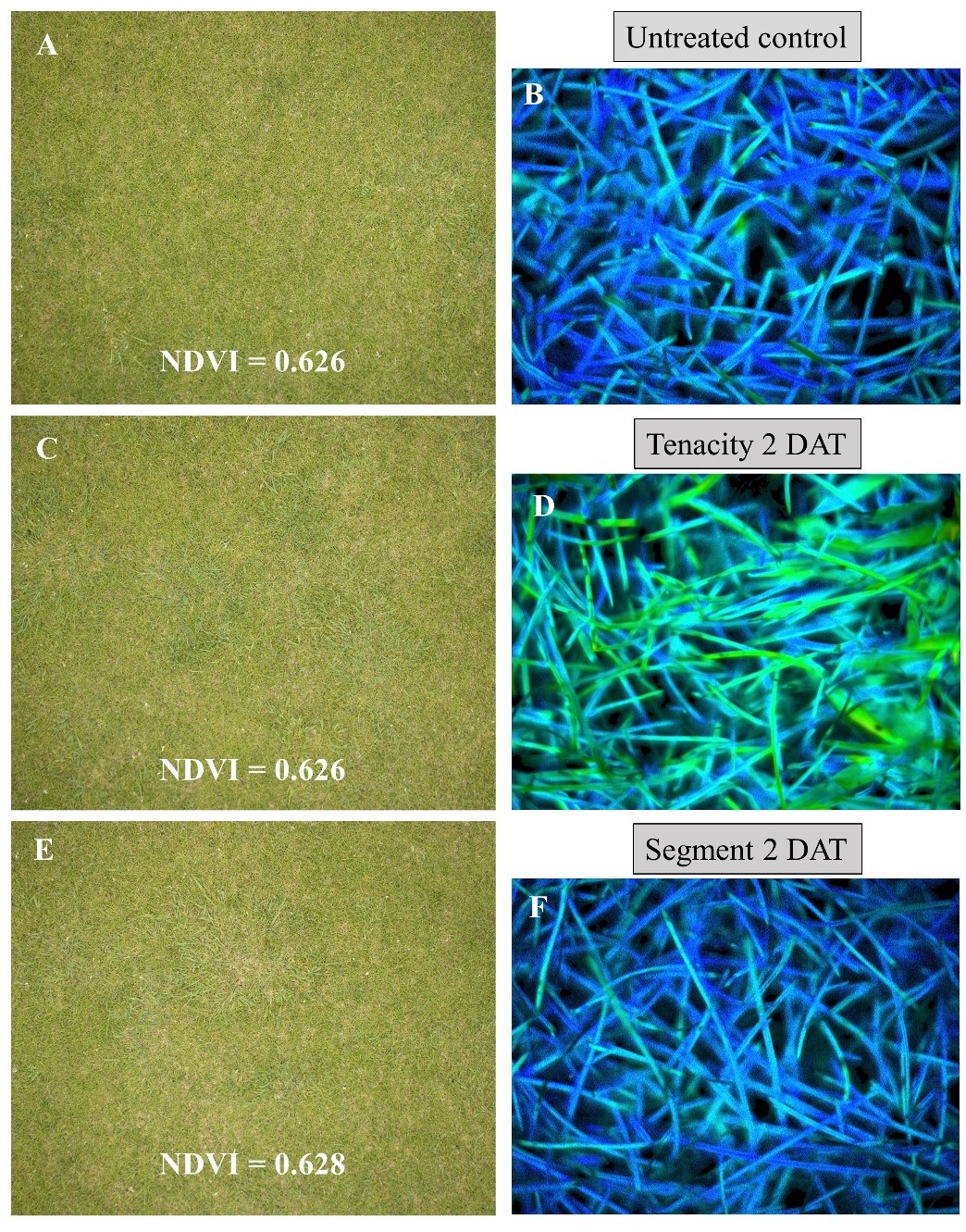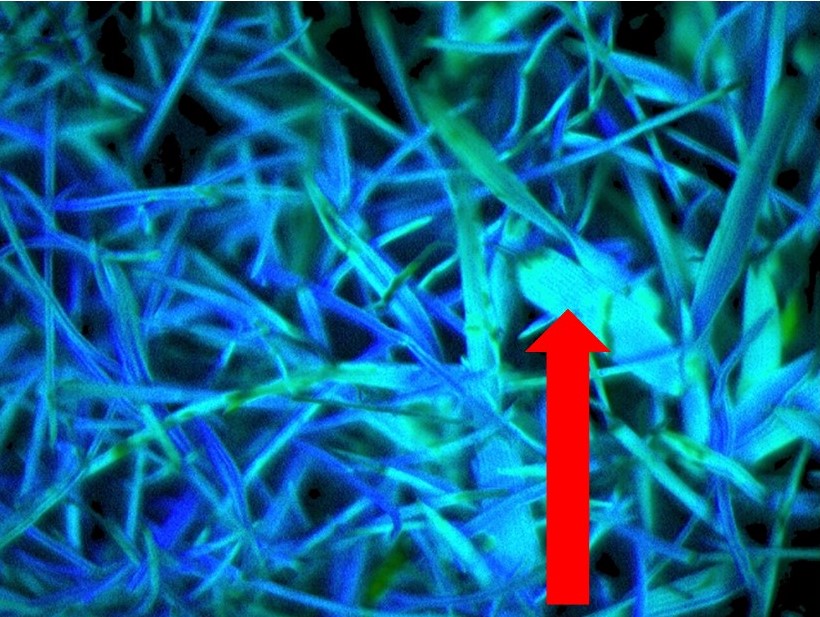By Dominic Petrella
Most golf course putting greens in Minnesota are comprised of creeping bentgrass and annual bluegrass, but other turfgrass species may be suitable alternatives. The University of Minnesota turf research program has investigated the use of fine fescue grasses on putting greens, as these are seen as a low-input option compared to creeping bentgrass putting greens. However, under certain circumstances, a greater amount of inputs may be required, such as herbicide to control weeds that may diminish the low-input attribute. While the most problematic weed to control on golf course putting greens is annual bluegrass, creeping bentgrass could also pose an issue for fine fescue putting greens. Creeping bentgrass may encroach onto a fescue putting green from the rough surrounding the green, from bentgrass stolons in the soil that survived a previous renovation, or as weed seed (Figure 1). Once the bentgrass is growing on the putting green surface, it is necessary to control it before it dominates and overgrows the fescue, as bentgrass is a faster growing grass.
Fine fescue putting greens require decreased fungicide applications due to a high tolerance to dollar spot (Clarireedia homoeocarpa) and other diseases, and fescue greens will generate less thatch due to the slower growth habit of the fine fescue turfgrasses, resulting in firmer greens. However, the numerous benefits offered by fine fescues may be diminished if the putting surface is overtaken by creeping bentgrass. It’s important to make sure to control creeping bentgrass that encroaches onto a fine fescue putting green, but it’s also important to make sure that the herbicide chosen doesn’t stress or damage the fine fescue to a large extent.
Starting June 10, 2019 we treated a fine fescue putting green established in fall of 2017 comprised of 60% Chewing’s fescue and 40% slender creeping red fescue with 2 different herbicides: 1) Tenacity – mesotrione (4 fl. oz. / Acre ) and 2) Segment - sethoxydim (0.8 fl. oz. / 1,000 ft2). Each of these herbicides will be applied 3 times in total, but we will either apply the products every 14 days or every 21 days as a means to decrease stress on the fine fescue. We are evaluating damage to the fine fescue visually and using digital images, we will also be evaluating percent control of creeping bentgrass in these plots. To further evaluate damage/stress to the fine fescue, we are taking normalized difference vegetation index (NDVI) data and we are monitoring photochemical efficiency (PE).
NDVI is used by many researchers to detect stress on turf, and it measures the relative reflectance of red and near-infrared light from leaves and can be used to monitor turfgrass color. NDVI is used to monitor plant health, but NDVI cannot predict what is happening within the leaf and may not be able to indicate damage from the herbicides being applied unless it’s already visible to the naked eye. On the other hand, PE is a measurement of how efficiently the light being absorbed by chlorophyll is being used for photosynthesis. These data are directly related to what is happening within the leaf (rather than on the outside of the leaf only), and PE is a precise tool for measuring plant stress. For monitoring PE, we are using an imaging technique that will allow us to see where the stress is located before we can see it with our eyes, improving our ability to see when and where the fine fescue is stressed.
On June 12, 2019 (2 days after treatment) we took digital images, NDVI data, and PE images at 1:00 pm. All plots looked the same visually and none of the herbicide treatments have yet to result in any phytotoxicity (Figure 2; A, C, E). NDVI data were also similar for all treatments. However, the PE images showed us that plots treated with Tenacity were stressed compared to the untreated control and plots treated with Segment (Figure 2; B, D, F). The average PE for control plots was 0.656, 0.543 for Tenacity, and 0.641 for segment. PE data near 0.800 are maximum, and values near 0.650 could be considered normal when data is taken during the day. Values below 0.600, like the data observed for Tenacity treated plots, indicate potential chronic stress. Based on the PE data, we would expect to see bleaching/whitening of the Tenacity treated plots starting over the next few days.
The PE images also allow us to be able to see differences in stress between fine fescue and the creeping bentgrass before we can see damage from the stress and even before NDVI measurements change (Figure 3). In a plot treated with Segment, we were able to see creeping bentgrass leaves showing a reduced photochemical efficiency compared to the fine fescue, indicating potentially successful weed control with limited fescue damage in the coming weeks. Overall, the PE data will help us determine if the fine fescue is stressed from these herbicide applications without visually seeing phytotoxicity. This may be able to help us fine tune cultural practices that occur near the time herbicide applications to limit other sources of stress that could further damage the fescue.


